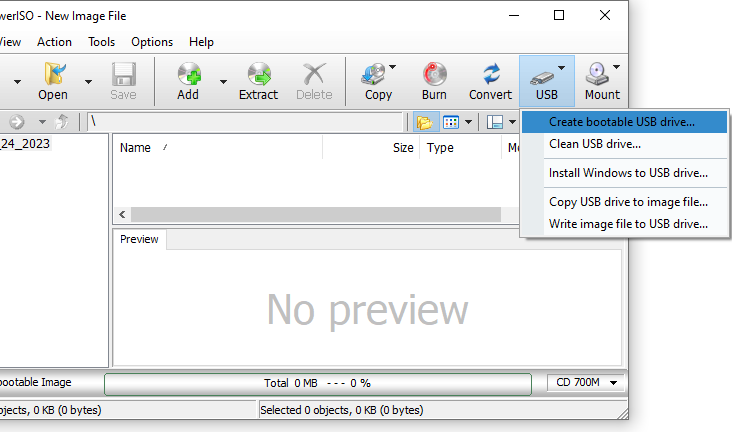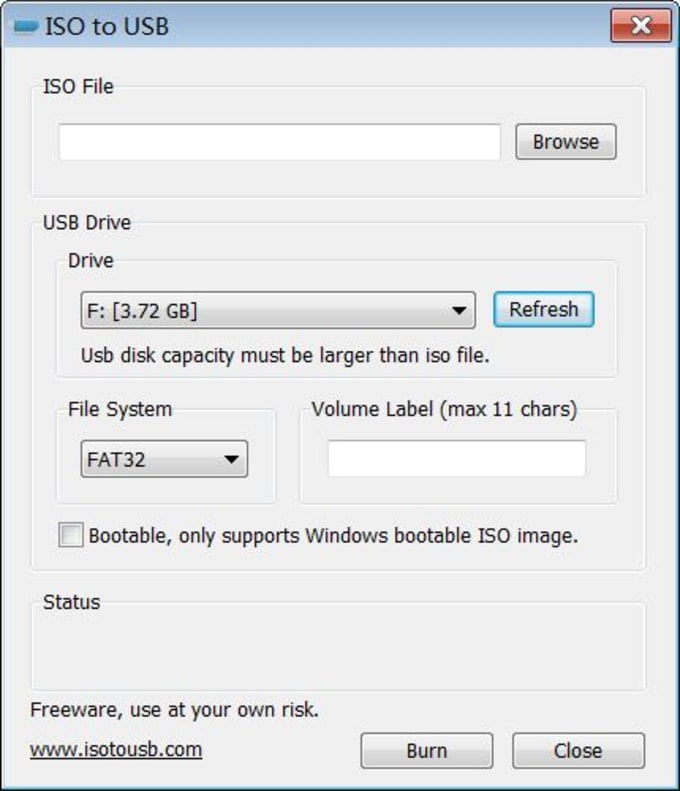

- #ISO TO USB WINDOWS HOW TO#
- #ISO TO USB WINDOWS INSTALL#
- #ISO TO USB WINDOWS WINDOWS 10#
- #ISO TO USB WINDOWS PORTABLE#
Once Imagewriter has been downloaded and installed, ensure that your USB stick is plugged in before starting it.Ī brief guide to writing the Manjaro. ImageWriter should be available for installation from your distribution's Software Center / Software Manager / Package Manager / repositories. More in Using a Burning Application ImageWriter User $ isohybrid -uefi -v output.iso COPY TO CLIPBOARD To burn the iso on an usb stick, enter the following command in a terminal :

Read the forum post on HowTo create a bootable Windows ISO Using the Terminal Windows ISO files are notoriously difficult and requires special attention.
#ISO TO USB WINDOWS HOW TO#
This section describes how to write a Linux ISO file to USB.
#ISO TO USB WINDOWS PORTABLE#
The portable version can be downloaded from here. Several free software burner applications are available for Windows. This will bring up a series of dialogues to walk you through the process.įor Windows Vista or older versions of Windows you will need to download 3rd party software. In Windows 7 and later, support for burning an ISO to DVD is built-in. If necessary, follow any on-screen instructions provided. Click the Burn button to start the burning process. Again, it is strongly recommended to select the slowest speed available. Click the properties button to open the properties window, and then click the button beneath the title Burning Speed. Otherwise, click the button to select it manually.Ħ. Underneath the title Select a disc to write to the blank CD/DVD inserted should already have been automatically listed. Upon automatically returning to the Image Burning Setup window, note that the ISO file is now listed as the disc image to write.ĥ. Locate and double-click the downloaded ISO file to load it. Click the button beneath the title Select a disc image to write to open up your file manager. Click the Burn Image - Burn an existing CD/DVD image to disc button to open the Image Burning Setup window.Ĥ. Insert a Blank CD/DVD (use a DVD if burning an ISO for anything other than the NET Edition)ģ. This will ensure your USB thumb drive is working properly which may be preventing a successful completion.1. Expand "Show advanced format options" under Format options in Rufus and check the option to "Check device for bad blocks". Pro Tip: If you are having issues creating your bootable USB thumb drive. The process may take several minutes depending on the speed of your USB thumb drive. Click OK on the confirmation screen to begin creating your bootable USB drive. The Format Options can usually be left as is, hit Start when you are ready. Once selected, just hit Open.įor image option, partition scheme and target system, I suggest using the defaults which are "Standard Windows Installation", GPT Partition Scheme and UEFI target system.
#ISO TO USB WINDOWS WINDOWS 10#
If you need to download a Windows 10 ISO file, check out this article. Next, click Select and navigate to your ISO file you want to use. To be safe, I typically use a 16GB thumb drive by Transcend.īy default, Rufus will only display removable USB drives but make sure the correct device is selected under Drive Properties. Make sure that your USB thumb drive is larger than the ISO file downloaded. Once installed, plug in your USB thumb drive and then start up Rufus. Alternatively you can download directly from the Github repository here. To get started, head over to and download Rufus 3.12 or later.
#ISO TO USB WINDOWS INSTALL#
This is very helpful when performing a clean install of the Windows 10 20H2 October update ISO. But recently I switched to using a new tool called Rufus that is both reliable at successfully creating bootable media and automating many steps to quickly get the job done so you can perform a clean install. I've written about a few methods over the years to create a bootable USB flash drive from a Windows 10 ISO file.


 0 kommentar(er)
0 kommentar(er)
